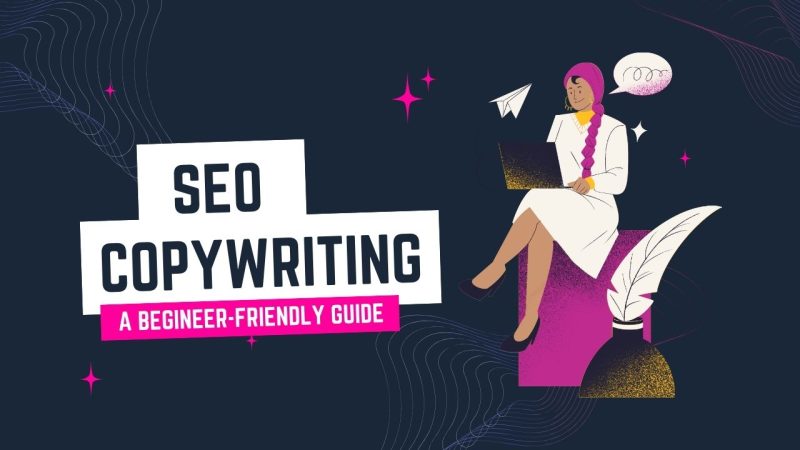In 2025, you will need more than just SEO knowledge to stand out. One such skill to acquire is copywriting.
Combining it with SEO can help you stand out if you are already familiar with copywriting.
SEO copywriting is creating keyword-optimized content that appeals to human users and search engine algorithms.
In simple terms:
SEO copywriting involves writing content that Google can easily understand while ensuring it’s engaging enough for people to read, link to, and share.
If you focus only on writing for Google, your content may sound robotic.

But if you write content ONLY for readers, your page might not include the important keywords that people are searching for.
It’s a tough balance to strike.
However, if you want to master SEO in 2025, you need to excel at both.
In this read, we will give some tips that can help you with both.
1. Structure the Content in the Right Way
Most people think SEO copywriting is all about stringing words together.
But in my experience, the STRUCTURE of your content is just as important as the writing itself.
A well-structured piece of content ensures that readers can easily find the information they are looking for, while search engines can better understand the relevance of your content. This means organizing your content into clear sections, using descriptive headings, and breaking up long paragraphs with bullet points or numbered lists when needed.
Should you need inspiration, some of the best content writing tools featured in this curated list by Attrock can create excellent outlines that help you plan your content.
For example, start with a compelling introduction that grabs attention, follow it with logically ordered sections, and end with a strong conclusion or call to action.
Additionally, make use of subheadings, which not only improve readability but also allow you to incorporate relevant keywords naturally.
One of the best examples of copywriting is by Coursera
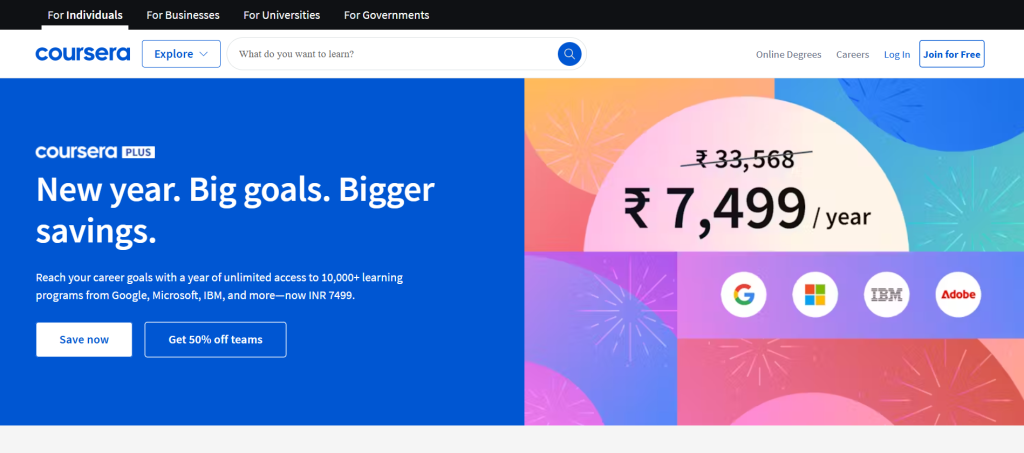
(For those of who don’t know, Coursera is an online course platform, you could find almost any skill here)
Next, now lets search in for some skill, we will look into “Python”

Let’s enter one of the courses with the most reviews, and here is the one.
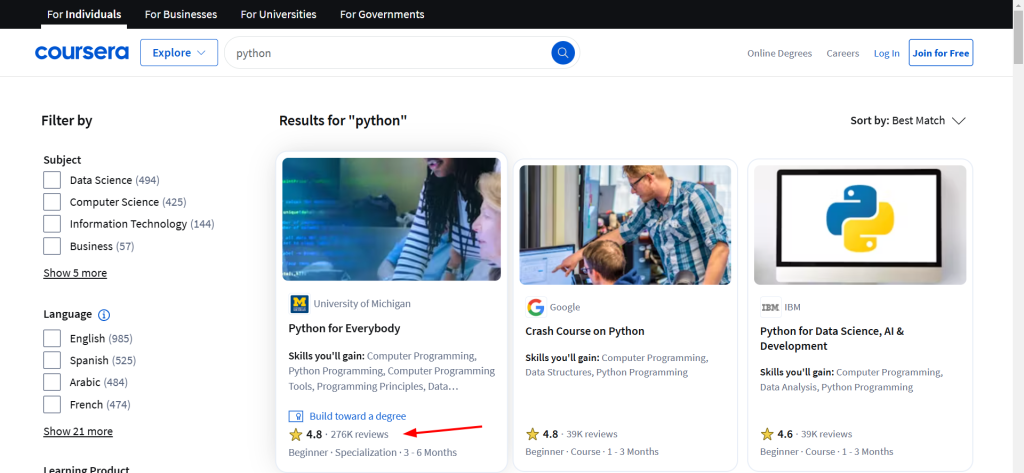
Now look at how they have structured the course, the things to lookout here are the heading and the subheading. How they have shown the people that have already engaged with their course. A time limit when student can learn the whole.
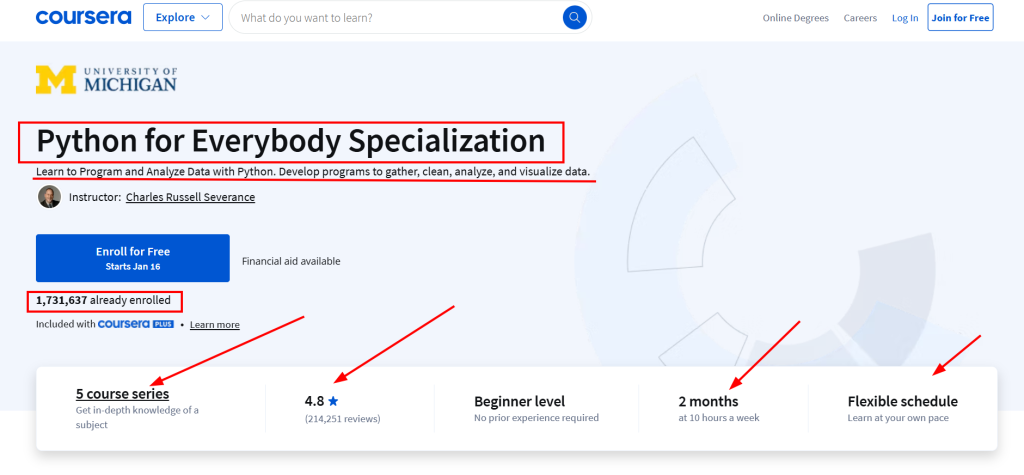
You don’t want to rip off the instructor’s course.
But you can use bits and pieces of the curriculum for your outline
2. Add Words so that someone sticks to your website for longer
When visitors arrive at your site from a search engine, two outcomes are possible:
- They leave almost immediately.
- They stay and explore further.
If people spend time engaging with your content, Google interprets it as a sign of quality and might reward your page with better rankings.
But if visitors bounce quickly? It signals that your content didn’t meet their expectations, and your rankings could take a hit.
So, how can you make sure people stay longer on your page?
One effective way is by using a short catchy sentense, classic copywriting method that grabs attention and keeps readers interested. These are short, punchy phrases designed to re-engage readers, particularly at points where they might lose focus or consider leaving your site.
The idea is simple:
Identify sections in your content where readers might get bored or feel overwhelmed. Insert quick, curiosity-driven sentences that make them want to continue reading.
Here’s how you can incorporate them:
- Add about 5-6 short, engaging lines throughout your content.
- Use phrases that spark interest or build anticipation.
For example:
- Here’s the thing:
- Imagine this:
- But wait, there’s more:
- Wondering why?
- This will surprise you:
- Here’s the best part:
- Let’s break it down:
These small additions create a conversational tone and make your content more engaging. Plus, when readers stay on your page longer, it signals search engines that your content is worth ranking higher.
3. Keep at least 10-15 LSI keywords in your Page
In today’s era of AI-driven search algorithms, Google isn’t concerned with how often you repeat a specific keyword in your content.
Instead, it focuses on understanding your content’s context using Latent Semantic Indexing (LSI) keywords.
LSI keywords are essentially synonyms or closely related terms that help Google grasp the overall theme of your page. By using these words naturally, you provide search engines with a clearer picture of your content’s relevance.
Finding LSI keywords is easy:
Search for the main keyword you want to rank for and scroll down to the bottom of Google’s search results page. There, you’ll find the “related searches” section, which highlights additional terms directly suggested by Google.
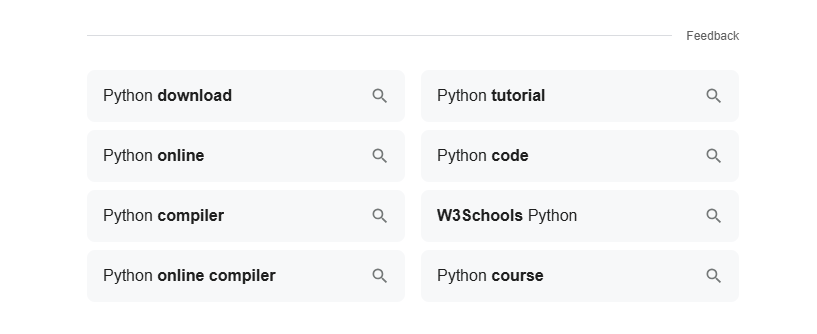
These related searches are excellent LSI keywords to sprinkle throughout your content. Including 10-15 of these terms not only improves your content’s relevance but also makes it more likely to rank for multiple variations of your target keyword.
4. Use Emotions in your titles
Research shows that headlines with emotional appeal tend to get higher click-through rates (CTR).
However, most of these studies focus on social media CTR, which may not directly reflect how users behave on Google.
Adding a touch of emotion to your title tags and meta descriptions—whether positive or negative—can make them more engaging. But moderation is crucial. Over-the-top emotional language can make searchers lose trust in your content and skip over your page in the search results.
5. Develop a Strategy, Approach or Concept
The first step is to create a strategy, approach, or concept that’s uniquely yours—and give it a name.
A great example is the Skyscraper Technique.
It was built on an existing idea (improving outdated content) but added an extra step that made it especially effective for link building.
This isn’t the only example. In marketing, many concepts we now consider standard started as named strategies that someone came up with:
- Blogs
- Inbound Marketing (popularized by HubSpot)
- Chatbots
- Influencer Marketing
- Conversion Rate
- Optimization
- Digital Marketing
In many cases, these ideas or practices existed long before they gained popularity. But they became widely recognized—and widely adopted—only when someone named them.
The takeaway? Giving your idea a name makes it feel real, tangible, and easier for others to remember and share.
There’s no exact formula for coming up with a catchy name, but it’s an important step in establishing your idea as something distinct and valuable.
6. Use Short URLs that You Want to Rank For
When it comes to ranking in search engines, the structure of your URL plays a significant role. Short, clean URLs are not only easier for users to read but also more likely to perform well in search rankings.
Why does this matter?
Short URLs are easier for Google to crawl and understand. They typically focus on the main keyword or topic of the page, which signals relevance to search engines. On the other hand, long, cluttered URLs with unnecessary parameters or excessive words can confuse both users and search engines.
For example:
Better URL:
example.com/seo-tips
Not-so-Good URL:
example.com/12345/article?id=2025&category=seo-tips
Short URLs also improve user experience. When users see a concise and relevant URL in search results, they’re more likely to trust and click on it.
Tips for creating short, rank-worthy URLs:
- Include your primary keyword: Focus on the main keyword for the page without overloading the URL with unnecessary words.
- Avoid stop words: Words like “and,” “the,” or “of” usually don’t add value and can make URLs longer.
- Keep it descriptive: Your URL should give users a clear idea of what the page is about.
- Eliminate unnecessary characters: Remove special characters, numbers, or dynamically generated parameters whenever possible.
7. Test Social Sharing Buttons on Your Pages
Social sharing buttons are a simple yet powerful way to encourage users to share your content. But just adding them to your pages isn’t enough—you need to ensure they’re functional, visible, and user-friendly.
Why is this important?
When users can easily share your content, it can reach a wider audience, drive more traffic to your site, and even generate valuable backlinks. However, broken or poorly placed sharing buttons can frustrate users and discourage them from spreading the word.
Here’s how to make sure your social sharing buttons work effectively:
- Test functionality: Regularly check that all buttons link to the correct social platforms and that the shared content includes the right title, URL, and meta description.
- Position strategically: Place sharing buttons where they’re easy to see—at the top, bottom, or alongside your content. Avoid cluttering the page by adding too many buttons.
- Optimize for mobile users: Make sure the buttons are responsive and easy to click on smaller screens.
- Track performance: Use analytics to see how often users interact with your sharing buttons. This data can help you identify which platforms drive the most engagement.
- Customize for branding: Use sharing buttons that match your website’s design and branding to ensure a cohesive look.
So that’s it for my guide to SEO copywriting!
Now, I’d love to hear from you:
Which tip from today’s post are you excited to try first?
Whether it’s crafting short, engaging URLs, experimenting with emotional titles, or developing a unique strategy, let me know your thoughts in the comments below. I can’t wait to see how you apply these techniques to take your content (and rankings) to the next level!
Published by
Adam White
Adam White is a 20+ year SEO professional who has optimized over 400 websites, built and sold over 20 internet and SaaS businesses all with SEO as the main traffic source. Follow him on Twitter/X
All stories by Adam White
